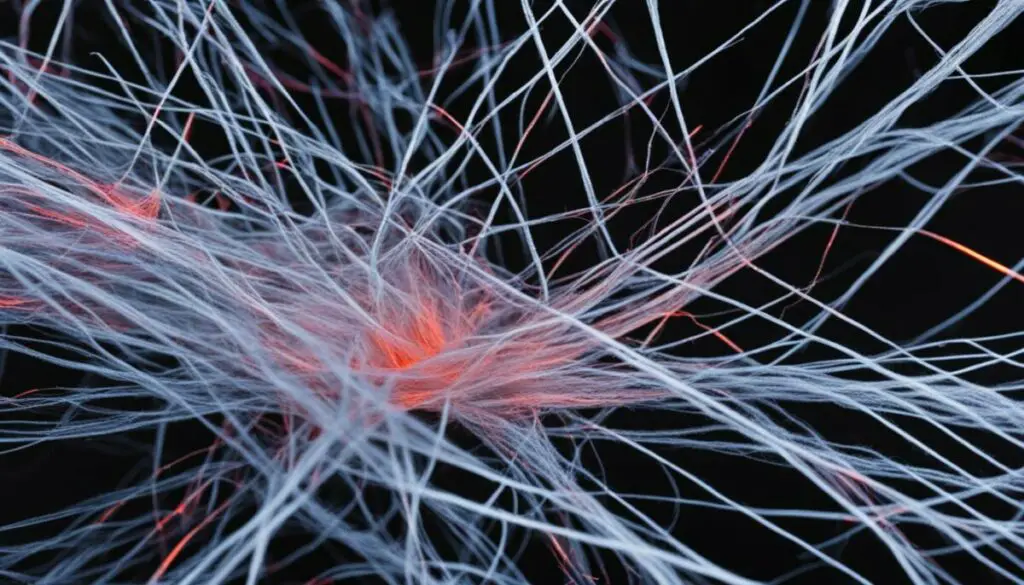Last Updated on 5 months by Francis
Have you ever wondered why infrared light is used in optical fiber? In this article, we will explore the benefits of using infrared in optical fiber and understand its significance in long-distance communication. So, let’s dive in and discover why infrared is such a crucial component of optical fiber technology!
Contents
Key Takeaways:
- Infrared light has longer wavelengths than visible light, resulting in lower attenuation in optical fibers.
- Lower attenuation allows for long-distance transmission of data with minimal loss of power.
- Infrared light experiences less absorption and scattering in glass fibers compared to visible light.
- Optical fibers typically use infrared wavelengths around 850, 1300, and 1550 nm for transmission.
- Plastic optical fiber (POF) uses shorter wavelengths, such as red light at 650 nm or 850 nm.
The Spectrum of Light and Infrared
In the world of optics, the spectrum of light encompasses a wide range of wavelengths, from the familiar colors of visible light to non-visible forms such as infrared. Infrared light lies between visible light and microwaves on the spectrum, with wavelengths ranging from 780 nm to 1,000,000 nm. It was first discovered in the 1800s by William Herschel, who noticed an increase in temperature beyond the visible red part of the spectrum. This discovery paved the way for the understanding and utilization of infrared light in various applications.
In the context of optical fiber communication, infrared light plays a crucial role. Its importance lies in its ability to transmit data with minimal loss. Compared to visible light, infrared light experiences less absorption and scattering in glass fibers, which are the primary medium for transmitting optical signals. This lower attenuation allows for long-distance transmission of data without significant loss of power. The use of infrared light in optical fiber communication has revolutionized the telecommunications industry, enabling high-speed and reliable communication over vast distances.
“Infrared light allows for the transmission of data with minimal loss.”
Beyond the realm of telecommunications, infrared light finds applications in various scientific fields. For instance, it is used in the James Webb telescope, which is designed to capture images from distant stars and nebulas. Supercooled infrared photodetectors in the telescope enable it to see through dust and capture light from objects billions of years old. This scientific application of infrared light demonstrates its significance in expanding our knowledge of the universe.
Table: Comparison of Visible Light and Infrared Light
| Visible Light | Infrared Light | |
|---|---|---|
| Wavelength Range | 400 nm – 700 nm | 780 nm – 1,000,000 nm |
| Attenuation in Glass Fibers | Higher | Lower |
| Applications | Color vision, illumination | Optical fiber communication, scientific research |
Heat and Infrared

Infrared light provides heat, such as the heat from the sun. Much of the sun’s energy is in the infrared frequency range, which heats objects directly without heating the surrounding air. Infrared light is absorbed by humans, animals, and plants, allowing them to feel the heat from the sun. In fiber optics, infrared light is used to transmit data because it experiences lower absorption (attenuation) in glass optical fibers, allowing for long-distance transmission with minimal loss of power. Without infrared light, long-distance communication through glass optical fibers would not be possible.
One of the key benefits of using infrared light in optical fiber is its ability to penetrate materials such as glass with minimal loss. This makes it the ideal choice for long-distance transmission of data. The longer wavelengths of infrared light allow it to travel through glass fibers without experiencing significant attenuation, enabling reliable communication over extended distances.
Furthermore, infrared light is less affected by interference from other light sources, making it more reliable for transmitting data. This is particularly important in environments where there are multiple light sources, such as in a data center or telecommunications network where various devices and equipment are present.
In summary, the use of infrared light in optical fiber offers several advantages, including efficient transmission over long distances and resistance to interference. Its ability to penetrate materials like glass without significant loss makes it an essential component of modern communication systems.
Infrared in Scientific Applications
Infrared light finds significant applications in various scientific fields, enabling researchers to explore and unlock new frontiers of knowledge. One notable application is in astronomy, where infrared light allows scientists to observe celestial objects that are not visible in other parts of the electromagnetic spectrum. For instance, the James Webb telescope, equipped with supercooled infrared photodetectors, can see through dust and capture images from distant stars and nebulas. By utilizing infrared light, the telescope provides valuable insights into the universe’s history, allowing scientists to study objects emitting light from billions of years ago.
In addition to astronomy, infrared light also plays a crucial role in medical imaging, helping doctors diagnose and treat various conditions. Infrared thermography, for example, utilizes the heat emitted by the human body to detect abnormalities and monitor changes in blood flow, making it a valuable tool for identifying potential health issues. Furthermore, infrared spectroscopy is used to analyze the molecular composition of substances, assisting chemists in identifying unknown compounds and monitoring chemical reactions.
“Infrared light has revolutionized the field of remote sensing, allowing us to gain a deeper understanding of the Earth’s surface and atmosphere. With thermal infrared cameras and sensors, researchers can study temperature patterns, vegetation health, and even identify hidden archaeological sites. The information gathered from these applications contributes to environmental research, urban planning, and resource management.”
Moreover, infrared light is extensively utilized in the defense and security industry. Infrared cameras and sensors enable night vision capabilities, enhancing situational awareness and aiding in surveillance operations. The ability to detect thermal signatures allows for the identification of potential threats, making infrared technology invaluable for military and law enforcement applications.
| Scientific Application | Significance of Infrared |
|---|---|
| Astronomy | Enables the observation of celestial objects that are not visible in other parts of the electromagnetic spectrum, providing insights into the universe’s history. |
| Medical Imaging | Facilitates the diagnosis and monitoring of health conditions through infrared thermography and spectroscopy, improving patient care. |
| Remote Sensing | Allows for the study of the Earth’s surface and atmosphere, aiding in environmental research, urban planning, and resource management. |
| Defense and Security | Enhances situational awareness, night vision capabilities, and threat detection for military and law enforcement purposes. |
Overall, the significance of infrared in scientific applications cannot be overstated. From unraveling the mysteries of the universe to improving healthcare and enhancing security, infrared light continues to revolutionize various fields of scientific research and technological advancements.
Infrared in Astronomy
Infrared light has revolutionized the field of astronomy, allowing scientists to observe celestial objects that are not visible in other parts of the electromagnetic spectrum. By utilizing supercooled infrared photodetectors, telescopes like the James Webb Space Telescope can capture images from distant stars and nebulas, providing valuable insights into the universe’s history. Infrared observations enable scientists to study objects emitting light from billions of years ago, expanding our understanding of the cosmos.
Infrared in Medical Imaging
Infrared light plays a crucial role in medical imaging, aiding in the diagnosis and treatment of various conditions. Infrared thermography utilizes the heat emitted by the human body to detect abnormalities and monitor changes in blood flow, making it a valuable tool for identifying potential health issues. Additionally, infrared spectroscopy allows chemists to analyze the molecular composition of substances, helping in the identification of unknown compounds and monitoring chemical reactions.
Infrared in Remote Sensing
Remote sensing utilizes infrared light to gain a deeper understanding of the Earth’s surface and atmosphere. Thermal infrared cameras and sensors enable the study of temperature patterns, vegetation health, and the identification of hidden archaeological sites. The information gathered from remote sensing applications contributes to environmental research, urban planning, and resource management, aiding in sustainable development.
Infrared in Defense and Security
Infrared technology has significant implications in the defense and security industry. Infrared cameras and sensors enable night vision capabilities, enhancing situational awareness and aiding in surveillance operations. By detecting thermal signatures, infrared technology can identify potential threats, making it invaluable for military and law enforcement applications.
Infrared Transmission in Optical Fiber
Infrared light is the preferred choice for transmission in optical fiber due to its lower attenuation in glass fibers. The attenuation of glass fibers is caused by absorption and scattering, and infrared light experiences less of both compared to visible light. By using infrared wavelengths, typically around 850, 1300, and 1550 nm, the attenuation of the fiber is significantly reduced. This allows for long-distance transmission of data without significant loss of power.
Transmitters (lasers or LEDs) and receivers (photodetectors) are specifically designed to operate at these wavelengths, ensuring efficient transmission and reception of signals through the optical fiber. The advantages of using infrared light in optical fiber can be summarized as follows:
- Lower Attenuation: Infrared light experiences less attenuation in glass fibers compared to visible light, enabling long-distance transmission of data.
- Wider Transmission Range: Infrared wavelengths, such as those around 850, 1300, and 1550 nm, allow for a broader range of data transmission.
- Power Efficiency: Infrared transmission in optical fiber minimizes the loss of power, ensuring efficient and reliable communication.
“Infrared light is the backbone of optical fiber communication, enabling high-speed, long-distance data transmission with minimal loss.”
Overall, the use of infrared light in optical fiber technology revolutionizes communication by providing a reliable and efficient means of transmitting data over long distances. The advantages of lower attenuation, wider transmission range, and power efficiency make infrared the preferred choice for optical fiber transmission.
Example Table – Attenuation Comparison
| Wavelength (nm) | Attenuation in dB/km (Visible Light) | Attenuation in dB/km (Infrared Light) |
|---|---|---|
| 650 | 30 | 3 |
| 850 | 10 | 0.1 |
| 1300 | 6 | 0.05 |
| 1550 | 0.5 | 0.01 |
Types of Infrared Fiber Optics

Infrared fiber optics can be classified into three main types: glass, crystalline, and hollow waveguides. Each type offers unique characteristics and materials that cater to specific applications in the field of infrared technology.
Glass Fibers
Glass fibers are the most common type of infrared fiber optics. These fibers are designed to have properties similar to silica, the primary component of traditional optical fibers. However, glass fibers have limitations in terms of losses and fragility compared to silica fibers. Despite these drawbacks, glass fibers are widely used in various applications due to their cost-effectiveness and compatibility with existing fiber optic systems.
Crystalline Fibers
Crystalline fibers are an alternative to glass fibers and offer unique properties suitable for specific applications. These fibers are made from crystalline materials such as sapphire or germanium. Crystalline fibers have higher melting or softening points and lower losses compared to glass fibers, making them ideal for high-temperature environments or applications that require high power transmission. However, crystalline fibers are more challenging to manufacture and are typically more expensive than glass fibers.
Hollow Waveguides
Hollow waveguides are a specialized type of infrared fiber optics that utilize an air core instead of a solid core. These waveguides are typically made from metals such as silver or gold and provide unique advantages for certain applications. Hollow waveguides allow for high-power transmission that is not achievable with solid-core fibers due to low laser damage thresholds. They are commonly used in laser power delivery systems and other applications that require efficient energy transfer.
| Type | Advantages | Disadvantages | Applications |
|---|---|---|---|
| Glass Fibers | Cost-effective, compatible with existing fiber optic systems | High losses, fragility | Telecommunications, internet infrastructure, scientific research |
| Crystalline Fibers | Higher melting points, lower losses | Higher cost, more challenging to manufacture | High-temperature environments, high-power transmission |
| Hollow Waveguides | High-power transmission, efficient energy transfer | Limited applications, specialized manufacturing | Laser power delivery, medical applications |
Table: Comparison of different types of infrared fiber optics
Properties of Infrared Fibers

Infrared fibers possess unique properties that differentiate them from conventional silica fibers. Understanding these characteristics is crucial for selecting the appropriate fiber for specific applications. Compared to silica fibers, infrared fibers typically have:
- Higher losses: Infrared fibers generally exhibit higher losses, limiting their usability in long-distance telecommunication applications.
- Larger refractive indices: The refractive index of infrared fibers is greater than that of silica fibers, affecting their light transmission properties.
- Lower melting or softening points: Infrared fibers have lower melting or softening points compared to silica fibers, which must be considered in high-temperature environments.
- Greater thermal expansion: Infrared fibers experience greater thermal expansion, making them more susceptible to dimensional changes with temperature fluctuations.
“Infrared fibers possess unique properties that differentiate them from conventional silica fibers.”
Despite their distinct properties, infrared fibers still find applications in various fields. Their wider transmission range and specific characteristics make them suitable for specialized uses such as chemical sensing, thermometry, and laser power delivery. Each application requires specific fiber properties, including high transmittance, low losses, and suitable refractive indices.
| Property | Characteristics |
|---|---|
| Losses | Higher than silica fibers |
| Refractive Indices | Larger than silica fibers |
| Melting or Softening Points | Lower than silica fibers |
| Thermal Expansion | Greater than silica fibers |
Applications of Infrared Fibers

Infrared fibers have a wide range of applications across various industries. Their unique properties and capabilities make them essential for specific uses where other fibers may not be suitable. Let’s explore some of the key applications of infrared fibers.
Chemical Sensing
Infrared fibers are extensively used in chemical sensing applications. Due to their higher refractive indices and specific coatings, these fibers can effectively interact with various chemical agents. The core of the fiber is surrounded by the target chemical or biological agent, allowing for precise detection and analysis. Infrared fibers enable real-time monitoring of chemical processes, environmental analysis, and detection of hazardous substances.
Laser Power Delivery
Hollow waveguides, a type of infrared fiber, play a crucial role in laser power delivery applications. This technology allows high-power lasers to be efficiently transmitted through the air core of the fiber. Solid-core infrared fibers have limitations due to low laser damage thresholds, making hollow waveguides a preferred choice for high-power laser systems. They are used in applications such as laser surgery, industrial laser cutting, and materials processing.
Radiometry and Thermal Imaging
Infrared fibers find extensive use in radiometry and thermal imaging applications. They transmit infrared radiation from objects of interest to detectors, enabling temperature measurements and thermal imaging. Infrared fibers are employed in devices such as thermal cameras, thermal imaging systems, and pyrometers. These applications are crucial in industries like aerospace, automotive, and building diagnostics.
In addition to chemical sensing, laser power delivery, and radiometry, infrared fibers are also utilized in fiber amplifiers and lasers, temperature measurements, and spectroscopy. Each application requires specific fiber properties, such as high transmittance, low losses, and suitable refractive indices, to achieve optimal performance.
Limitations of Infrared Fibers

While infrared fibers offer numerous advantages in optical fiber technology, they also have certain limitations that must be considered. These limitations can impact their use in different applications and pose challenges for their widespread adoption.
One major limitation of infrared fibers is their relatively high loss compared to silica fibers. This restricts their use to shorter lengths, making them less suitable for long-distance communication. The high loss also limits their application in telecommunications, where kilometer lengths of fiber are commonly used. Additionally, infrared fibers are more fragile compared to silica fibers, which can affect their durability and increase the risk of damage during installation and operation.
These limitations have slowed the acceptance and widespread use of infrared fibers, particularly in telecommunication applications. However, ongoing research and development efforts are focused on understanding and mitigating the sources of high losses in infrared fibers. By addressing these challenges, it may be possible to overcome the limitations and expand the range of applications for infrared fibers.
Despite their limitations, the unique properties of infrared fibers make them indispensable in specific areas such as chemical sensing, thermometry, and laser power delivery. Ongoing advancements in the field hold promise for improving the performance of infrared fibers and opening up new possibilities for their use in various industries.
Table 1 provides a summary of the limitations of infrared fibers and the challenges associated with their use:
| Limitations of Infrared Fibers | Challenges of Using IR Fibers |
|---|---|
| High loss compared to silica fibers | Restricts use to shorter lengths |
| More fragile compared to silica fibers | Affects durability and risk of damage |
| Slowed acceptance and limited use in telecommunications | Less suitable for long-distance communication |
Table 1: Summary of limitations and challenges of using infrared fibers.
Future Developments in Infrared Fiber Optics
The field of infrared fiber optics is poised for significant advancements in the near future. Ongoing research and development efforts are focused on improving the performance and expanding the applications of infrared fibers. As technology continues to evolve, several key areas of advancement are anticipated that will shape the future of infrared fiber optics.
Advancements in Loss Reduction
One of the primary areas of focus in infrared fiber optics research is the reduction of losses in infrared fibers. High losses have been a limiting factor in the widespread adoption of these fibers, especially for long-distance communication applications. Researchers are exploring new fiber designs and materials to minimize the loss of infrared light during transmission. By improving the quality and efficiency of infrared fibers, the potential for longer link distances and more reliable communication systems can be realized.
Enhanced Durability and Reliability
Another area of development in infrared fiber optics is the improvement of fiber durability and reliability. Fragility has been a concern with infrared fibers, and efforts are underway to enhance their physical robustness without compromising optical performance. This includes exploring new manufacturing techniques and materials that will result in infrared fibers that can withstand challenging environmental conditions and can be deployed in a wider range of applications.
New Fiber Materials and Structures
Advancements in infrared fiber optics are also expected to involve the development of new fiber materials and structures. Researchers are exploring novel materials with improved optical properties, such as lower losses and expanded transmission ranges. Additionally, the introduction of new fiber structures, such as photonic crystal fibers and hollow core fibers, holds promise for enabling innovative applications and improved performance in infrared fiber optics systems.
| Advancement | Description |
|---|---|
| Loss Reduction | Efforts to minimize the loss of infrared light during transmission, improving the quality and efficiency of infrared fibers. |
| Durability and Reliability | Development of more robust infrared fibers that can withstand challenging environmental conditions. |
| New Fiber Materials and Structures | Exploration of novel materials and structures with enhanced optical properties and expanded transmission ranges. |
The future of infrared fiber optics holds great promise for advancements in loss reduction, enhanced durability and reliability, and the development of new fiber materials and structures. These advancements will enable more efficient and reliable communication systems, expand the range of applications for infrared fibers, and drive innovation in the fiber optic industry. As research and development continue to progress, the potential for even greater breakthroughs in infrared fiber optics technology is on the horizon.
Implications for the Fiber Optic Industry
Infrared technology has had a significant impact on the fiber optic industry, revolutionizing the way data is transmitted over long distances. The role of infrared in optical communication cannot be overstated, as it provides a reliable and efficient means of data transfer. By utilizing infrared light, fiber optic systems can achieve high-speed communication with minimal loss of power.
The advantages of using infrared light in optical fiber are numerous. The lower attenuation and wider transmission range of infrared wavelengths make it an essential technology for sectors such as telecommunications, internet infrastructure, and scientific research. The ability to transmit data over long distances without significant power loss has made infrared a key component in high-speed, long-distance communication.
The ongoing advancements in infrared fiber optics will continue to shape the fiber optic industry. Ongoing research and development are focused on reducing losses in infrared fibers, increasing their durability, and developing new fiber materials with enhanced properties. These advancements are expected to drive innovation and expand the applications of infrared fiber optics in the future.
Table: Applications of Infrared in the Fiber Optic Industry
| Application | Description |
|---|---|
| Telecommunications | Infrared enables efficient and reliable long-distance data transmission in fiber optic networks. |
| Internet Infrastructure | Infrared plays a crucial role in providing fast and reliable internet connectivity through fiber optic cables. |
| Scientific Research | Infrared is used in scientific applications such as telescopes to capture images from distant stars and nebulas. |
| Laser Power Delivery | Infrared fibers are used for delivering high-power laser energy in applications such as medical equipment and materials processing. |
| Chemical Sensing | Infrared fibers enable the detection and analysis of chemicals and biological agents using evanescent-wave sensors. |
The future of infrared fiber optics is promising, with ongoing advancements aimed at overcoming the limitations and challenges associated with infrared fibers. The development of new fiber materials and improved transmission techniques will further enhance the efficiency and reliability of infrared fiber optic systems. As technology continues to evolve, we can expect to see even greater innovation and expanded applications for infrared fiber optics in the fiber optic industry.
Conclusion
Infrared light serves as a vital component in optical fiber technology, revolutionizing long-distance communication. By leveraging its longer wavelengths and lower attenuation in glass fibers, infrared light enables high-speed, reliable data transmission with minimal power loss. This has made it the preferred choice for various sectors, including telecommunications, internet infrastructure, and scientific research.
With its wide transmission range and numerous applications, infrared fibers have proven invaluable in fields such as chemical sensing, laser power delivery, and radiometry. Despite limitations and challenges, ongoing research and advancements in infrared fiber optics hold promise for future improvements and expanded applications.
The use of infrared light in optical fibers has not only transformed communication but also continues to drive innovation in the fiber optic industry. As technology progresses, further breakthroughs in reducing losses, increasing durability, and developing new fiber materials are anticipated. The implications are immense, with the potential for lower attenuation, higher transmission efficiency, and even broader applications in the future.
FAQ
Why is infrared used in optical fiber?
Infrared light is used in optical fiber because it has longer wavelengths than visible light, resulting in lower attenuation (loss of signal) in the glass fibers.
What is the role of infrared in optical fiber communication?
Infrared light allows for the transmission of data with minimal loss, making it essential for long-distance communication through glass optical fibers.
What are the benefits of using infrared light in optical fiber?
Infrared light experiences less absorption and scattering in glass fibers compared to visible light, allowing for longer distance transmission of data with minimal power loss.
What are the applications of infrared in scientific research?
Infrared light is used in scientific applications such as the James Webb telescope to see through dust and capture images from distant stars and nebulas.
Why is infrared preferred in optical fiber transmission?
Infrared light has lower attenuation in glass fibers compared to visible light, allowing for efficient and reliable data transmission over long distances.
What are the types of infrared fiber optics?
Infrared fiber optics can be categorized into glass, crystalline, and hollow waveguides, each with different materials and structures depending on the application.
What are the properties of infrared fibers?
Infrared fibers have higher losses, larger refractive indices, lower melting or softening points, and greater thermal expansion compared to traditional silica fibers.
What are the applications of infrared fibers?
Infrared fibers are used for laser power delivery, chemical sensing, radiometry, thermal imaging, fiber amplifiers and lasers, and temperature measurements in various fields.
What are the limitations of infrared fibers?
The high loss and fragility of infrared fibers restrict their use to short lengths and specific applications such as chemical sensing and laser power delivery.
What is the future of infrared fiber optics?
Ongoing research aims to reduce losses in infrared fibers, increase durability, and develop new fiber materials with enhanced properties to expand their applications.
What is the impact of infrared on the fiber optic industry?
Infrared is a crucial component of the fiber optic industry, enabling efficient and reliable data transmission over long distances and driving innovation in high-speed communication.









